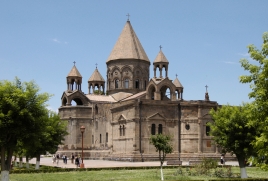Armenian Apostolic Church
Tuesday, August 17, 2021
The Armenian Apostolic Church is the national church of the Armenian people. Part of Oriental Orthodoxy, it is one of the most ancient Christian institutions. The Kingdom of Armenia was the first state to adopt Christianity as its official religion under the rule of King Tiridates III of the Arsacid dynasty in the early 4th century.According to tradition, the church originated in the missions of Apostles Bartholomew and Thaddeus of Edessa in the 1st century.
It is sometimes referred to as the Armenian Orthodox Church or the Armenian Gregorian Church. The term Gregorian Church is not preferred by the church itself, as it views the Apostles Bartholomew and Thaddeus as its founders, and St. Gregory the Illuminator as merely the first official governor of the church. It is also known simply as the Armenian Church.
The Armenian Orthodox Church believes in apostolic succession through the apostles Bartholomew and Thaddeus of Edessa.According to tradition, the latter of the two apostles is said to have cured Abgar V of Edessa of leprosy with the Image of Edessa, leading to his conversion in 30 AD. Thaddaeus was then commissioned by Abgar to proselytize throughout Armenia, where he converted the king Sanatruk's daughter, who was eventually martyred alongside Thaddeus when Sanatruk later fell into apostasy. After this, Bartholomew came to Armenia, bringing a portrait of the Virgin Mary, which he placed in a nunnery he founded over a former temple of Anahit. Bartholomew then converted the sister of Sanatruk, who once again martyred a female relative and the apostle who converted her. Both apostles ordained native bishops before their execution, and some other Armenians had been ordained outside of Armenia by James the Just. Scholars including Bart Ehrman, Han Drijvers, and W. Bauer dismiss the conversion of Abgar V as fiction.
According to Eusebius and Tertullian, Armenian Christians were persecuted by kings Axidares, Khosrov I, and Tiridates III, the last of whom was converted to Christianity by Gregory the Illuminator. Ancient Armenia's adoption of Christianity as a state religion (the first state to do so) has been referred to by Nina Garsoïan as "probably the most crucial step in its history." This conversion distinguished it from its Iranian and Mazdean roots and protected it from further Parthian influence. According to Mary Boyce, the acceptance of Christianity by the Arsacid-Armenian rulers was partly in defiance of the Sassanids.
When King Tiridates III made Christianity the state religion of Armenia between 301 and 314, it was not an entirely new religion there. It had penetrated the country from at least the third century, and may have been present even earlier.
Tiridates declared Gregory to be the first Catholicos of the Armenian Orthodox Church and sent him to Caesarea to be consecrated. Upon his return, Gregory tore down shrines to idols, built churches and monasteries, and ordained many priests and bishops. While meditating in the old capital city of Vagharshapat, Gregory had a vision of Christ descending to the earth and striking it with a hammer. From that spot arose a great Christian temple with a huge cross. He was convinced that God intended him to build the main Armenian church there. With the king's help he did so in accordance with his vision, renaming the city Etchmiadzin, which means "the place of the descent of the Only-Begotten".
Initially, the Armenian Orthodox Church participated in the larger Christian world and was subordinated to the Bishop of Caesarea. Its Catholicos was represented at the First Council of Nicea (325). St. Vrtanes I the third Catholicos of the Armenian Apostolic Church through (333–341 AD), sent a letter with specific questions to Macarius of Jerusalem who was the Greek Orthodox Bishop of Jerusalem from (312-335, or 336 AD) sent to Jerusalem by a delegation of Armenian priests on the occasion of the Encaenia, in dedication of the Church of the Holy Sepulcher in Jerusalem in September 335 AD. In Macarius's letter to the Armenians in 335 AD, it seeks to correct irregularities in the initiation rites of Baptism and the Eucharist currently in use in the Armenian Church by articulating present practices in Jerusalem. In so doing, it reveals the divergent forms being practiced in Armenia, which have strong echoes of old East Syriac Rite. Orthopraxy was conceived by Vrtanes and his Armenian colleagues in terms of liturgical performance in Jerusalem. In 353, King Papas (Pap) appointed Catholicos Husik without first sending him to Caesarea for commissioning. Its Catholicos was still represented at the First Council of Constantinople (381).
As Gregory was consecrated by the bishop of Caesarea, he also accepted the Byzantine Rite. However, the Armenian Church, due to the influence of the Church in Edessa, the large presence of Syriacs in Armenia, as well as the number of Syriac priests that arrived in Armenia with Gregory, also cultivated the West Syriac Rite (Antiochian Rite). Since Armenians at the time didn't have an alphabet, its clergy learned Greek and Syriac language. From this synthesis, the new Armenian Rite came about, which had similarities both with the Byzantine and the Antiochian Syriac rite.
Christianity was strengthened in Armenia in the 5th century by the translation of the Bible into the Armenian language by the native theologian, monk, and scholar, Saint Mesrop Mashtots. Before the 5th century, Armenians had a spoken language, but it was not written. Thus, the Bible and Liturgy were written in Greek or Syriac rather than Armenian. The Catholicos Sahak commissioned Mesrop to create the Armenian alphabet, which he completed in 406. Subsequently, the Bible and Liturgy were translated into Armenian and written in the new script. The translation of the Bible, along with works of history, literature and philosophy, caused a flowering of Armenian literature and a broader cultural renaissance.
Although unable to attend the Council of Ephesus (431), Catholicos Isaac Parthiev sent a message agreeing with its decisions. However, non doctrinal elements in the Council of Chalcedon (451) caused certain problems to arise.





